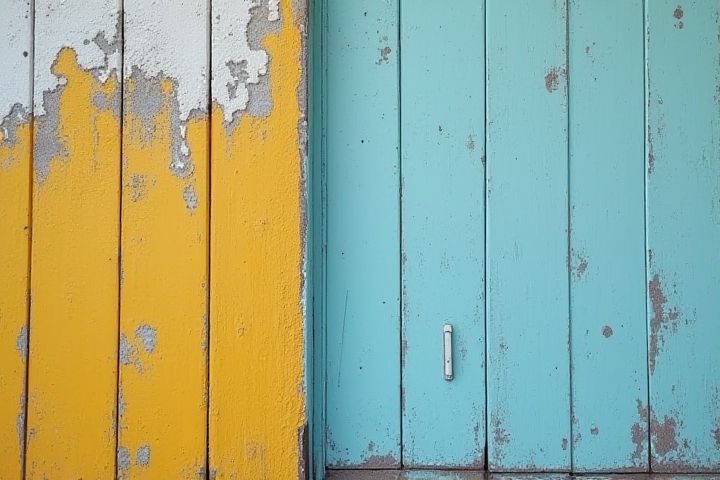
Repainting your house is essential every 5 to 10 years to maintain its aesthetic appeal and protect the exterior surfaces from weather-related damage. Signs that it's time to repaint include noticeable fading, peeling, or bubbling of the paint, which can compromise the protective barrier. If you notice cracks forming in the walls or mold and mildew growth, it's a clear indication that the existing paint is failing. Inspect areas that receive direct sunlight, as UV rays can accelerate paint degradation in those spots. Regular maintenance and timely repainting ensure your home remains visually appealing and structurally sound.
When To Repaint A House
Fading and discoloration
Fading and discoloration are clear indicators that it's time to repaint your house, typically noticed after 5 to 7 years for exteriors in moderate climates. Direct sunlight can expedite this process, leading to significant color loss, especially in vibrant shades like reds or blues. If you observe uneven patches or peeling in certain areas, it may signify a need for immediate attention to maintain your home's aesthetic and value. Regular inspections every couple of years can help you catch these issues early, ensuring your property remains visually appealing.
Peeling or cracking paint
Peeling or cracking paint is a clear sign that your home needs repainting, typically indicating underlying moisture issues or poor surface preparation. If you notice these defects in more than 10% of your exterior surfaces, it's crucial to take action immediately to prevent further damage. Fresh paint not only enhances curb appeal but also protects the house from elements like UV rays and rain, ultimately prolonging its lifespan. Regular inspections every 3 to 5 years can help you identify these problems early, ensuring your home maintains its value and aesthetic.
Visible water stains or mold
Visible water stains or mold are clear indicators that it's time to repaint your house. These stains not only affect the aesthetic appeal of your home but can also indicate underlying moisture issues that require immediate attention. If you notice discolored patches on walls or ceilings, it's essential to address the source of moisture before applying a new coat of paint. Repainting over these blemishes without proper remediation can lead to recurring problems and impact the indoor air quality of your living space.
Chalking of the paint surface
Chalking occurs when the paint begins to break down and form a powdery residue on the surface, which is often visible after exposure to UV rays and harsh weather conditions. If you notice this chalky film on your home's exterior, it indicates that the paint is failing and may require repainting. Typically, you should check for chalking every 5 to 7 years, as this can help preserve the integrity of your home's surface and appearance. By repainting promptly when chalking occurs, you can enhance your home's curb appeal and protect it from further damage.
Checking for bubbling or blistering
Bubbling or blistering paint indicates that moisture is trapped beneath the surface, often due to poor ventilation or high humidity levels, leading to potential damage. Inspect your exterior and interior walls at least once a year for these signs, especially during seasonal transitions. If you notice more than 10% of the painted surface exhibiting bubbles or blisters, it's a strong indication that repainting is necessary. Addressing this issue promptly can prevent further structural damage and maintain your home's aesthetic appeal.
Damaged or rotten wood
When identifying the right time to repaint your house, look for signs of damaged or rotten wood, which can compromise the integrity of your structure. Wood that has begun to decay may display visible cracks, flaking paint, or a soft, sponge-like texture, indicating moisture infiltration. If left unaddressed, this damage can lead to more costly repairs, affecting up to 30% of your exterior surfaces. Inspect your home every three to five years, focusing on areas prone to water accumulation, to ensure that any wood damage is promptly dealt with before repainting.
Signs of rust on metal surfaces
Signs of rust on metal surfaces typically indicate that it's time to repaint your house. When you observe flaking paint, discoloration, or a rough texture, these are clear indicators of corrosion. Rust may not only compromise the aesthetic appeal but can also weaken the structural integrity of metal fixtures, leading to costly repairs. Addressing rust promptly by repainting can extend the life of your metal surfaces and enhance the overall protection of your property.
Susceptibility to harsh weather conditions
Repainting your house is crucial if it has been exposed to harsh weather conditions, which can significantly deteriorate exterior paint and underlying materials. Typically, homes in regions with extreme temperatures, heavy rainfall, or intense sunlight require a fresh coat of paint every 5 to 7 years. Signs of peeling, fading, or cracking paint are clear indicators that your home is vulnerable and needs immediate attention to protect against moisture and pests. Investing in high-quality, weather-resistant paint can extend the lifespan of your exterior protection, ensuring your home remains visually appealing and structurally sound.
Changes in personal taste or color preferences
Repainting your house can be a significant decision, particularly influenced by changes in personal taste or color preferences. Research shows that 40% of homeowners opt for a new color scheme every 5 to 7 years. Factors such as trends, emotional responses to colors, and the desire for a refreshed environment may prompt you to reconsider your home's appearance. Selecting colors that resonate with your current lifestyle can enhance the overall aesthetic and increase your property's value.
Preparation for selling the property
Repainting your house before selling can significantly enhance its market appeal, making a fresh coat of paint a valuable investment. Aim to repaint at least 2-3 weeks before listing the property, as this allows ample time for drying and finishing touches. Research indicates that homes with newly painted exteriors can see a return on investment of up to 107%. Choose neutral colors to attract a wider range of potential buyers, as these shades create a more inviting atmosphere.
